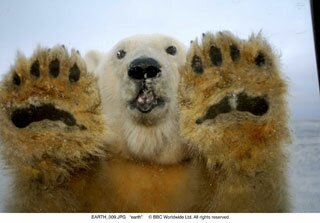MOVIE REVIEW- Heavenly <i>Earth</i>: Are polar bears the new penguins?

PUBLICITY PHOTO
Some of the beautiful nature photography in Earth is enough to make Bill Maher believe in God.
Some of the savagery shown in Earth (or implied, to keep it G-rated) is enough to reinforce the concept of a vengeful, Old Testament God.
The spiritual aspect is no doubt enhanced by James Earl Jones' "voice of God" narration. His voice should be on any list of the Seven Natural Wonders of the World.
Earth marks Walt Disney Pictures' return to nature documentaries after a hiatus of nearly half a century, no doubt inspired at least in part by the surprise success of March of the Penguins. Earth substitutes marketing muscle for that film's intrinsic appeal.
There's an attempt to impose some structure on the random series of minidramas and pretty pictures when Jones announces at the outset we're going to spend "a year with our fellow creatures," and we begin in January in the Arctic.
The polar bear family we meet features in one of the few continuing story lines. An absentee father is looking for food for himself, facing the problem of ice melting because of global warming, while Mama Bear and her two cubs end their hibernation and begin their own migration. "It's unlikely that both cubs will survive their first year," Jones warns us before we can get too attached.
So polar bears are the new penguins? Maybe not. We're soon circling the globe like the conifer forest a thousand miles south of the North Pole, looking in on a variety of animals as winter gives way to spring– at least in the Temperate Zones.
We're told that three million caribou migrate across the tundra. We don't see all of them, just a representative sampling being stalked by wolves. A calf strays from the herd and is chased by a wolf. The film cuts away before things get too messy, but you'll probably be able to see this and other kills on the unrated DVD.
Spectacular montages of changing colors take us out of the calendar format for a moment, as does our time in the tropics, where the sun shines 12 hours a day all year round.
Mandarin ducks learning to fly and the mating rituals of exotic birds of paradise in New Guinea provide diversion. If you want to see the actual mating, you'll have to get that unrated DVD. (Hey, I'm giving Disney ideas. I should get a commission if they really do it!)
Elephants migrating across the Kalahari Desert provide another continuing storyline, so maybe elephants are the new penguins. Or maybe humpback whales are, as we follow a mother and baby on their long migration, supposedly threatened at one point by a great white shark, although we never see them together.
"This is the circle of life," Jones intones, cross-plugging another Disney product as a leopard stalks an antelope. The definition of "predator" obviously depends on whose story is being told. Sharks are predators to whales, but it's OK for the whales to devour thousands of smaller fish in a single bite.
In a strange scene, the desperate Papa Bear attacks a female walrus in an attempt to get at her baby, and she has to fight him off herself while the dozens of walrus in close proximity, who could easily shred the bear with their tusks, pay no attention.
As summer comes to the Southern Hemisphere in October a brief shot of some penguins confirms that they are the new penguins.
A brief look at "the most amazing light show on earth" does not convince that the Aurora Australis, or Southern Lights, are any more amazing than their northern counterparts.
George Fenton's score seems to be competing with Jones' narration at times. The result is overpowering and not in a good way.
Making-of footage during the credits will answer some of your questions about how they got those shots. There are more than enough of "those shots" to make Earth worth seeing, even if they could have been organized better or left admittedly disorganized. Pretension isn't natural, except maybe for birds of paradise.
#